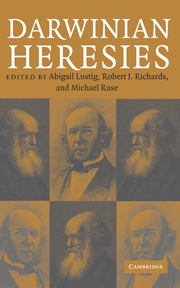Book contents
- Frontmatter
- Contents
- List of Contributors
- 1 Introduction: Biologists on Crusade
- 2 Russian Theoretical Biology between Heresy and Orthodoxy: Georgii Shaposhnikov and His Experiments on Plant Lice
- 3 The Specter of Darwinism: The Popular Image of Darwinism in Early Twentieth-Century Britain
- 4 Natural Atheology
- 5 Ironic Heresy: How Young-Earth Creationists Came to Embrace Rapid Microevolution by Means of Natural Selection
- 6 If This Be Heresy: Haeckel's Conversion to Darwinism
- 7 Adaptive Landscapes and Dynamic Equilibrium: The Spencerian Contribution to Twentieth-Century American Evolutionary Biology
- 8 “The Ninth Mortal Sin”: The Lamarckism of W. M. Wheeler
- 9 Contemporary Darwinism and Religion
- Index
8 - “The Ninth Mortal Sin”: The Lamarckism of W. M. Wheeler
Published online by Cambridge University Press: 11 July 2009
- Frontmatter
- Contents
- List of Contributors
- 1 Introduction: Biologists on Crusade
- 2 Russian Theoretical Biology between Heresy and Orthodoxy: Georgii Shaposhnikov and His Experiments on Plant Lice
- 3 The Specter of Darwinism: The Popular Image of Darwinism in Early Twentieth-Century Britain
- 4 Natural Atheology
- 5 Ironic Heresy: How Young-Earth Creationists Came to Embrace Rapid Microevolution by Means of Natural Selection
- 6 If This Be Heresy: Haeckel's Conversion to Darwinism
- 7 Adaptive Landscapes and Dynamic Equilibrium: The Spencerian Contribution to Twentieth-Century American Evolutionary Biology
- 8 “The Ninth Mortal Sin”: The Lamarckism of W. M. Wheeler
- 9 Contemporary Darwinism and Religion
- Index
Summary
INTRODUCTION
In a lecture to the philosophical Royce Club of Harvard in 1917, William Morton Wheeler jovially referred to Lamarckism as “the ninth mortal sin.” Wheeler (1865–1937) was by then the world's leading figure in myrmecology (the study of ants), and there was a serious comment underlying his remark; something about his practice of myrmecology had placed him outside the orthodoxy of biology. A sketch of his career hints at why this might be so. Wheeler had formalized an early interest in natural history when he went to Chicago to study embryology under C. O. Whitman. Moving to Texas some time later, he became intrigued by the local ant fauna and returned to his earlier natural-historical passions. The fascination with myrmecology lasted for the remaining forty or so years of his life, to the virtual exclusion of all other types of animal – humans excepted. Most of this time (1908–37) was spent at Harvard. A romantic natural historian at heart, Wheeler was uncomfortably lodged with the applied biologists in the graduate school; by preference he mixed with Cambridge's philosophers, psychologists, and sociologists, along with the zoologists in the Museum of Comparative Zoology.
Ants had long been a riddle to evolutionists like Wheeler; though individually simple, their group behavior was extremely complex, embracing activities that were variously interpreted as fungus farming, aphid farming, slave making, mutual feeding, brood nursing, nest building, caste creation, and warfare, not to mention their manifold ecological relationships with other species, both within and without the nest.
- Type
- Chapter
- Information
- Darwinian Heresies , pp. 151 - 172Publisher: Cambridge University PressPrint publication year: 2004
- 5
- Cited by

